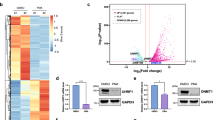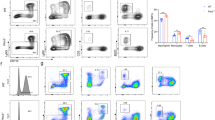Abstract
Metallothioneins (MTs), a group of small, cystein-rich proteins, possess various functions, including metal detoxification and homeostasis. We here report new findings on the participation of MT in cellular differentiation processes. MT isogene transcription was significantly increased in phorbol-12-myristate-13-acetate (PMA) incubated leukemic DAMI cells, which supports its role in cellular differentiation. To further address this possibility, we constructed one stable MT-2A overexpressing DAMI cell line. Increase of cell size, intracellular granulation and megakaryocytic specific antigen expression such as CD41 and CD42, and arresting cell proliferation have validated the role of MT in differentiation in this cell line.



Similar content being viewed by others
Abbreviations
- DMSO:
-
Dimethyl sulfoxide
- FCS:
-
Fetal calf serum
- FITC:
-
Fluorescein isothiocyanate
- FSC:
-
Forward light scatter
- GAPDH:
-
Glyceraldehyde-3-phosphate dehydrogenase
- IHC:
-
Immunohistochemical staining
- MGG:
-
May-Grünwald–Giemsa staining
- MT:
-
Metallothionein
- PMA:
-
Phorbol-12-myristate-13-acetate
- SSC:
-
Side scatter channel
References
Kagi JHR (1991) Overview of metallothionein. Methods Enzymol 205:613–625
Miles AT, Hawksworth GM, Beattie JH, Rodilla V (2000) Induction, regulation, degradation, and biological significance of mammalian metallothioneins. Crit Rev Biochem Mol Biol 35:35–70
Thornalley PJ, Vasak M (1985) Possible role for metallothionein in protection against radiation-induced oxidative stress. Kinetics and mechanism of its reaction with superoxide and hydroxyl radicals. Biochem Biophys Acta 827:36–44
Cai L, Cherian MG (2003) Zinc-metallothionein protects from DNA damage induced by radiation better than glutathione and copper- or cadmium-metallothioneins. Toxicol Lett 136:193–198
West AK, Stallings R, Hildebrand CE, Chiu R, Karin M, Richards RI (1990) Human metallothionein genes: structure of the functional locus at 16q13. Genomics 8:513–518
Stennard FA, Holloway AF, Hamilton J, West AK (1994) Characterization of six additional human metallothionein genes. Biochim Biophys Acta 1218:357–365
Palmiter RD, Findley SD, Whitmore TE, Durnam DM (1992) MT-III, a brain-specific member of the metallothionein gene family. Proc Natl Acad Sci USA 89:6333–6337
Quaife CJ, Findley SD, Erickson JC, Froelick GJ, Kelly EJ, Zambrowicz BP, Palmiter RD (1994) Induction of a new metallothionein isoform (MT-IV) occurs during differentiation of stratified squamous epithelia. Biochemistry 33:7250–7259
Greenberg SM, Rosenthal DS, Greeley TA, Tantravahi R, Handin RI (1988) Characterization of a new megakaryocytic cell line: the Dami cell. Blood 72:1968–1977
Long MW, Heffner CH, Williams JL, Prochownik EV (1990) Regulation of megakaryocyte phenotype in human erythroleukemia cells. J Clin Investig 85:1072–1084
Mididoddi S, Mcguirt JP, Sens MA, Todd JH, Sens DA (1996) Isoform-specific expression of metallothionein mRNA in the developing and adult human kidney. Toxicol Lett 85:17–27
Maghdooni Bagheri P, Rahman MT, Van Soest S, De Ley M (2009) Differential quantitative zinc-induced expression of human metallothionein isogenes in haematopoietic precursor cell lines. J Trace Elem Med Biol 23:124–131
Vuong H, Patterson T, Adiseshaiah P, Shapiro P, Kalvakolanu DV, Reddy SPM (2002) JNK1 and AP-1 regulate PMA-inducible squamous differentiation marker expression in Clara-like H441 cells. Am J Physiol Lung Cell Mol Physiol 282:L215–L225
Jacquel A, Herrant M, Defamie V, Belhacene N, Colosetti P, Marchetti S, Legros L, Deckert M, Mari B, Cassuto J-P, Hofman P, Auberger P (2006) A survey of the signaling pathways involved in megakaryocytic differentiation of the human K562 leukemia cell line by molecular and c-DNA array analysis. Oncogene 25:781–794
Cherian MG, Jayasurya A, Bay BH (2003) Metallothioneins in human tumors and potential roles in carcinogenesis. Mutat Res 533:201–209
Cherian MG, Apostolova MD (2000) Nuclear localization of metallothionein during cell proliferation and differentiation. Cell Mol Biol 46:347–356
Saito H (1997) Megakaryocytic cell lines. Baillieres Clin Haematol 10:47–63
Hassan HT, Freund M (1995) Review of megakaryoblastic cell lines, characteristic biological features of human megakaryoblastic leukaemia cell lines. Leuk Res 19:589–594
Acknowledgments
We would like to thank Dr. Dominique Schols and Eric Fonteyn for their help with the flow cytometric experiments. We are grateful to K.U. Leuven for a research fellowship (P.M.B).
Author information
Authors and Affiliations
Corresponding author
Rights and permissions
About this article
Cite this article
Maghdooni Bagheri, P., Govaerts, I. & De Ley, M. Role of metallothionein in differentiation of leukemia cells. Mol Biol Rep 38, 3017–3022 (2011). https://doi.org/10.1007/s11033-010-9967-7
Received:
Accepted:
Published:
Issue Date:
DOI: https://doi.org/10.1007/s11033-010-9967-7




